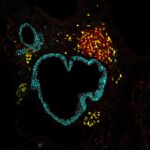
Publication: In vivo imaging of the spatiotemporal activity of the eIF2α-ATF4 signaling pathway: Insights into stress and related disorders.
Published in: Sci Signal 2015 Apr; 8(374): rs5
Authors: Chaveroux C, Carraro V, Canaple L, Averous J, Maurin AC, Jousse C, Muranishi Y, Parry L, Mesclon F, Gatti E, Mallet J, Ravassard P, Pierre P, Fafournoux P, Bruhat A
Summary
The eIF2α-ATF4 pathway is involved in cellular adaptation to stress and is dysregulated in numerous diseases. Activation of this pathway leads to phosphorylation of the α subunit of eukaryotic initiation factor 2 (eIF2α) and the recruitment of the transcription factor ATF4 (activating transcription factor 4) to specific CCAAT/enhancer binding protein (C/EBP)-ATF response elements (CAREs) located in the promoters of target genes. To monitor the spatiotemporal modulation of this pathway in living animals, we generated a novel CARE-driven luciferase mouse model (CARE-LUC). These transgenic mice enable the investigation of the eIF2α-ATF4 pathway activity in the whole organism and at the tissue and cellular levels by combining imaging, luciferase assays, and immunochemistry. Using this mouse line, we showed the tissue-specific activation pattern of this pathway in response to amino acid deficiency or endoplasmic reticulum stress and the hepatic induction of this pathway in a stress-related pathology model of liver fibrosis. The CARE-LUC mouse model represents an innovative tool to investigate the eIF2α-ATF4 axis and to develop drugs targeting this important pathway in the remediation of related pathologies.
Link to Pubmed [PMID] – 25921292
Link to DOI – 10.1126/scisignal.aaa0549

